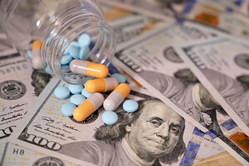Therapeutic Transparency Essential to Solving America’s Rising Rx Expenses
U.S. prescription drug prices, the highest in the world, are particularly problematic for minorities and people of color, says Paul Ford, Founder and President of DS9 Capital. One possible solution is greater pricing and therapeutic transparency.

A new report from the Rand Corporation shows that prescription drug prices in the United States, particularly for brand-name drugs, are more than twice as high as in other countries. In the 32 nations surveyed in the report, the US accounted for 58% of the total spend, but only 24% of the consumption.(1) While elevated US drug prices affect everyone in the country, notes Paul Ford, founder and president of DS9 Capital, they particularly disadvantage people of color and other minorities. “Approximately 60% of Americans are on medication,” says Ford. “There are people making $90,000 a year who have difficulties paying for medicine. How can lesser-paid people cope? And it’s worse for the under- and uninsured.”
Faced with an unmanageably expensive prescription, Ford observes, some patients simply do without the medicine, while others resort to cutting pills in half or skipping doses. It doesn’t, he adds, look as though the situation will improve anytime soon. In recent years, 41 drugs increased more than 100% in price in the US, including the widely used antidepressant Prozac, which went up 879%.(2)
There are, says Ford, a number of factors contributing to high US prescription prices:
- Lack of regulation. While the Food and Drug Administration regulates how drugs are tested, marketed, and released for sale, it has no control over price.
- Exclusivity protection. When a new drug hits the market. It is immediately placed under patent and drug exclusivity.
- Price hikes in the supply chain. The actions of insurance companies and pharmacy benefit managers can have a significant effect on drug prices.
- Administrative costs.
- Limited market competition.(3)
Faced with escalating drug costs, many Americans turn to prescription discount cards. With the card, they may pay significantly less for certain prescriptions. The consumer does not pay for the card. Rather, discount card services make their money by charging the participating pharmacies and supermarkets in their network a small fee for each transaction.(4) Physicians, notes Ford, tend to be unaware of drug costs and lack the realization of the large difference in cost between inexpensive and expensive drugs.(5)
Meanwhile, the Biden administration has announced a prescription drug pricing plan as part of its Build Back Better initiative. The plan, as announced, will:
- Allow Medicare to negotiate drug prices.
- Impose a tax penalty if drug companies increase their prices faster than inflation.
- Directly lower out-of-pocket drug costs for seniors.(6)
What is needed, says Ford, is a sort of clearinghouse for information that acts as a transparent interface between the consumers of pharmaceutical products (i.e., patients and their providers: pharmaceutical manufacturers, digital therapeutics, and bio sciences companies). Working through a network of retail and independent pharmacies, it would deliver a personalized approach to healthcare providing lower cost treatment alternatives, evaluating pricing and therapeutic alternatives that do not sacrifice drug effectiveness and cost less.
There is, in fact, such an organization, says Ford. OrchestraRx is a LegitScript Certified prescription drug management and data company founded on inclusion, healthy outcomes, consumerism, and technology. While it functions as a personalized health treatment optimizer, it does not own any pharmacies.(7)
This, says Ford, is the future for pharma. “The fact that a private organization has stepped up and provided this service,” he says, “is a very encouraging, and very ambitious with results. It’s a case of a visionary business understanding what needs to be done and—without trying to corner or manipulate any part of the market, works within the existing market to optimize outcomes dynamically.”
About DS9 Capital:
DS9 Capital is a founder-friendly portfolio management holding company focused on building enduring and stable cash-flowing businesses in the insurance and healthcare technology space. DS9 is generally focused on frontier technology and service offerings in the insurance and healthcare space largely leveraging cloud-based infrastructure, and more specifically on applying our domain expertise to nano-cap sized businesses to expand the value chain for all stakeholders. This value creation typically includes investment, leveraging our vast resources and networks to create a strategic pipeline for organic growth and realigning the businesses to optimize commercial and IP assets. Our tactical goal with each of our companies is to leverage our expertise into higher margin and missed revenue opportunities.
1. Curley, Christopher. “U.S. Prescription Drug Prices Are Twice as High.” Healthline, 3 Feb. 2021, healthline.com/health-news/prescription-drug-prices-in-the-u-s-are-twice-as-high-heres-why.
2. Frakt, Austin, Benavidez, Gilbert. “Racial Disparities, Prescription Medications, and Promoting Equity.” Public Health Post, 21 Aug. 2018, publichealthpost.org/viewpoints/racial-disparities-prescription-medications-equity/.
3. “Why Are Prescription Drugs More Expensive in the U.S. than in Other Countries?” GoodRx, goodrx.com/healthcare-access/drug-cost-and-savings/why-are-prescription-drugs-more-expensive-in-the-us-than-in-other-countries.
4. “Discount Drug Cards Promise Huge Savings on Your Prescriptions. but Is There a Catch?” Money, money.com/discount-drug-cards-promise-huge-savings-on-your-prescriptions-but-is-there-a-catch/.
5. “Physician Awareness of Drug Cost: A Systematic Review.” PLoS Medicine, U.S. National Library of Medicine, pubmed.ncbi.nlm.nih.gov/17896856/.
6. “Digital Patient Acquisition Platform.” OrchestraRx, orchestrarx.com/.
7. “President Biden Announces Prescription Drug Pricing Plan in Build Back Better Framework.” The White House, The United States Government, 2 Nov. 2021, whitehouse.gov/briefing-room/statements-releases/2021/11/02/president-biden-announces-prescription-drug-pricing-plan-in-build-back-better-framework/.


